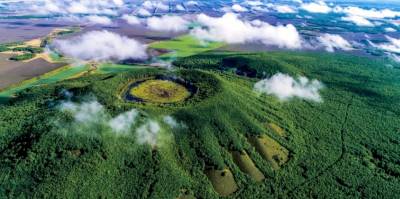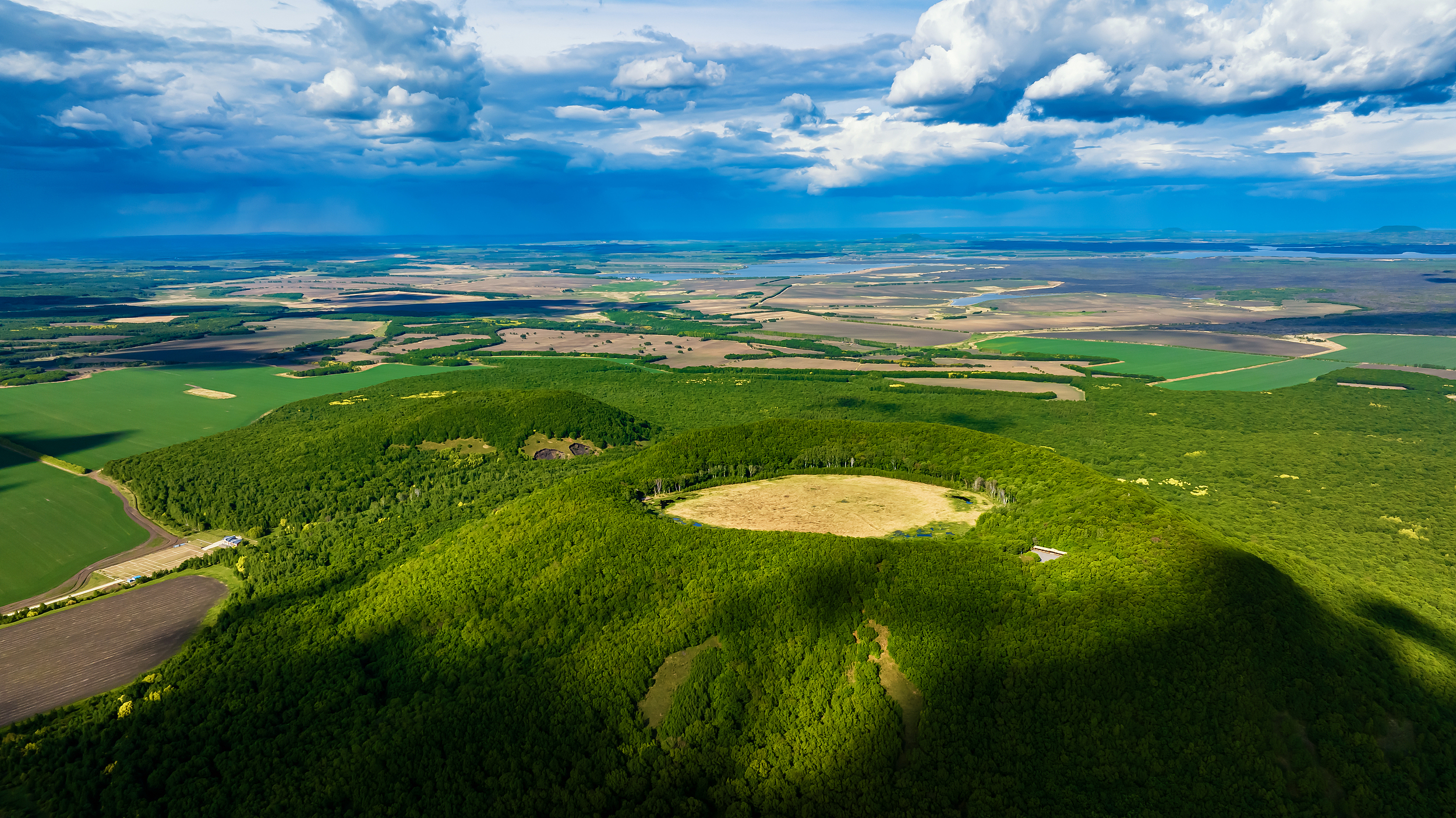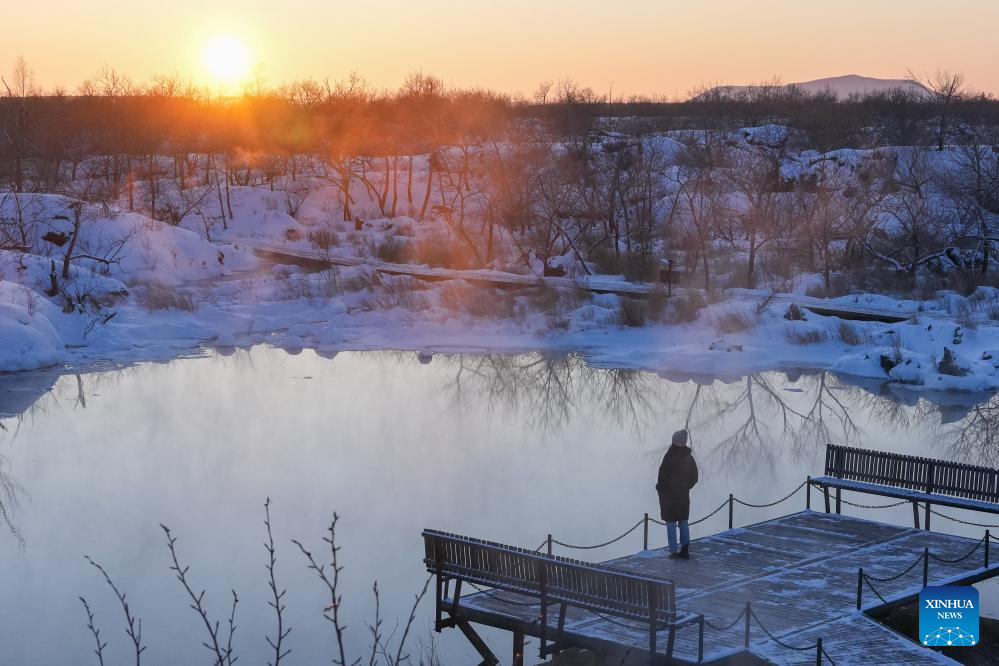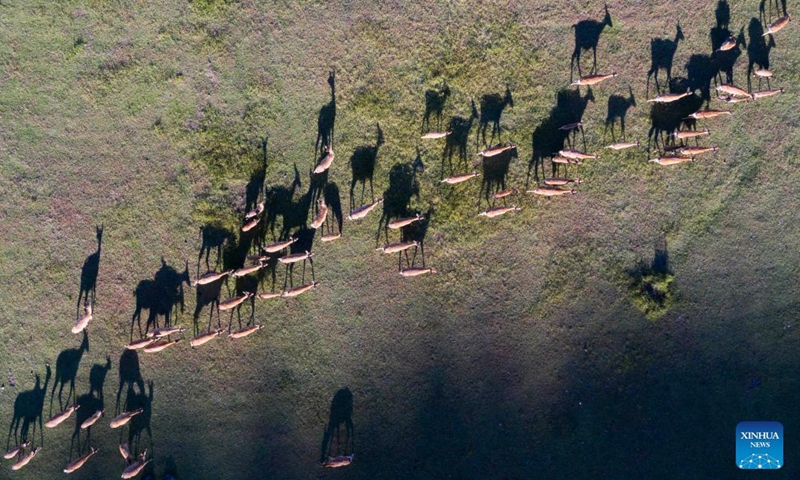Discover the Natural Wonders of Heihe Wudalianchi: A Travel Guide

An Essential Guide to Visiting Heihe_Wudalianchi
Nestled in the northeastern corner of China, where the Heilongjiang River embraces the border with Russia, lies Heihe, a city steeped in rich history and vibrant culture. This unique destination serves not only as a bustling trade hub but also as a gateway to the breathtaking Wudalianchi Global Geopark, famous for its striking volcanic landscapes and a series of interconnected lakes. As you stroll through the streets of Heihe, you’ll be greeted by a fascinating blend of Chinese and Russian influences, evident in everything from its architecture to its cuisine.
Wudalianchi, meaning “Five Large Connected Lakes,” is the crowning jewel of this region, offering visitors an enchanting escape into nature. Here, you can explore fourteen dormant volcanoes, each telling a story of the Earth’s fiery past, while the mineral-rich waters promise rejuvenation and relaxation. Whether you’re hiking along the scenic trails, marveling at the unique geological formations, or immersing yourself in local cultural festivals, Heihe and Wudalianchi provide an unforgettable experience that beckons adventurers and history enthusiasts alike.
Prepare to embark on a journey that transcends borders, as you discover the wonders of Heihe and the natural beauty of Wudalianchi—a destination that beautifully encapsulates the essence of northeastern China.
In This Guide
- An Essential Guide to Visiting Heihe_Wudalianchi
- The Rich History and Legends of Heihe_Wudalianchi
- Main Highlights: What You Absolutely Can’t Miss
- Planning Your Visit: A Practical Guide
- Tickets: Prices, Booking, and Tips
- How to Get There: A Complete Transportation Guide
- Local Cuisine and Accommodation Nearby
- Frequently Asked Questions
- Final Thoughts on Your Trip
The Rich History and Legends of Heihe_Wudalianchi
Nestled in the stunning landscapes of northeastern China, Heihe and the Wudalianchi area boast a rich tapestry of history and legends that beckon travelers to explore. The ancient city of Heihe, known as 黑河 (hēi hé), has a history that stretches back to the Paleolithic Age, making it one of the five ancient cities of Heilongjiang Province. This region, inhabited by local tribes for centuries, became a strategic military hub during the Qing Dynasty. It was here that the first troops dispatched to Heilongjiang were stationed, marking the city’s importance in China’s historical narrative.
The geographical positioning of Heihe is remarkable; it sits directly across the Heilongjiang River from the Russian city of Blagoveshchensk, fostering a unique cultural and economic exchange. Strolling through the streets of Heihe, one can witness the blend of Chinese and Russian influences, evident in the bilingual signs and the bustling markets filled with Russian goods. The proximity to Russia has made Heihe a significant trade center, further enriching its historical significance as a bridge between two cultures.
Wudalianchi, translating to “Five Large Connected Lakes,” is an extraordinary natural wonder that lies a short distance from Heihe. This area is not just a geological marvel but is steeped in local legends. The lakes were formed by ancient volcanic eruptions, and the surrounding landscape is dotted with fourteen volcanoes, creating a dramatic backdrop rich in folklore. Local tales often speak of how these lakes were formed by the tears of a heartbroken goddess, mourning the loss of her beloved. Travelers who visit Wudalianchi may find themselves enchanted by the beauty of the lakes and the mystical stories that envelop them.
The cultural significance of Wudalianchi extends beyond its geological features; it is also a site of wellness and healing. The mineral waters that flow from the volcanic rocks are believed to possess restorative properties, attracting visitors seeking health benefits. This aspect of Wudalianchi’s history has led to the establishment of wellness resorts, where ancient practices meet modern relaxation techniques, allowing visitors to immerse themselves in both nature and local traditions.
In addition to its natural beauty and historical depth, Wudalianchi hosts lively festivals throughout the year, particularly the Heilongjiang International Volcano Tourism Festival and the Wudalianchi Drinking Festival. These events bring together locals and tourists alike, celebrating the rich cultural heritage of the region through performances, traditional dances, and vibrant community gatherings.
For international travelers, the allure of Heihe and Wudalianchi lies not just in their breathtaking landscapes, but also in the stories and history that breathe life into the area. Whether wandering through the ancient streets of Heihe, marveling at the volcanic lakes, or delving into the legends that shape this region, visitors are bound to leave with a deeper appreciation of the cultural and historical significance that defines Heihe and Wudalianchi.

Heihe_Wudalianchi.
Main Highlights: What You Absolutely Can’t Miss
Heihe and Wudalianchi are a treasure trove for travelers seeking to explore the unique blend of natural beauty and cultural richness in northeastern China. Here’s a detailed guide to the must-see highlights that you absolutely can’t miss during your visit.
Wudalianchi Global Geopark
At the heart of the Heihe experience is the Wudalianchi Global Geopark, renowned for its stunning volcanic landscapes and the mesmerizing Five Large Connected Lakes. Formed by ancient lava flows, this geopark offers a unique opportunity to witness geological wonders. Here, you can hike along well-maintained paths that weave through lush birch forests and volcanic rock formations, taking in breathtaking views of the lakes and surrounding volcanoes.
The main attraction, Black Dragon Hill, invites adventurous souls to ascend its slopes. The trek to the summit rewards you with panoramic vistas of the crater and the surrounding area, where the stark beauty of the lava formations creates an otherworldly atmosphere. Don’t forget your camera—the landscape here is truly Instagram-worthy!
Natural Mineral Springs
After exploring the volcanic terrain, rejuvenate yourself at the local mineral springs. These naturally carbonated waters are not only refreshing but also reputed for their health benefits. A visit to the springs offers a chance to relax and enjoy the serene environment, making it a perfect break between your explorations.
Cultural Festivals
Timing your visit to coincide with one of the local festivals can enhance your experience. The Heilongjiang International Volcano Tourism Festival and the Wudalianchi Drinking Festival are vibrant events that feature cultural performances, outdoor movies, and traditional dance shows such as the Dragon Dance and Yangge Dance. These festivals are fantastic opportunities to immerse yourself in local culture while enjoying the stunning natural backdrop.
Skiing Resorts
For winter sports enthusiasts, the Longzhu Far East International Skiing Resort and the Woniuhu Skiing Resort are excellent destinations. Nestled on the border with Russia, these resorts offer a variety of skiing opportunities against a picturesque snowy landscape, making it a great getaway for both seasoned skiers and families alike.
Exploring the Town of Heihe
Don’t overlook the city of Heihe itself. This bustling border town showcases an intriguing mix of Chinese and Russian cultures, evident in the bilingual signage and varied culinary offerings. Stroll through the streets, sample local dishes, and perhaps bring home unique Russian souvenirs from the vibrant markets, especially along the east section of Hailan Jie, which is famous for its Russian goods.
Scenic Walks and Outdoor Activities
Wudalianchi also offers multiple scenic walks, including trails around the lakes and through the forested areas. The “Sea of Rocks”, a fascinating lava formation, is not to be missed. You can take a leisurely walk along wooden walkways that lead you through the stunning natural landscape, allowing you to appreciate the geology up close.
For adventure seekers, activities like hiking, photography, and even exploring the Crystal Palace or the underground Ice Cave provide memorable experiences that showcase the region’s diverse offerings.
Conclusion
Heihe and Wudalianchi are not just destinations; they are experiences waiting to unfold. Whether you are drawn by the geological wonders, cultural festivals, or the charm of the border town, this region promises a captivating journey that will leave a lasting impression. Make sure to allocate enough time to soak in all the breathtaking views and rich cultural experiences that Heihe and Wudalianchi have to offer.

Heihe_Wudalianchi.
Planning Your Visit: A Practical Guide
Planning Your Visit: A Practical Guide to Heihe and Wudalianchi
Nestled in the northeastern corner of China, Heihe is a city where rich cultural exchanges with Russia thrive, while the stunning natural wonders of Wudalianchi beckon adventure seekers. Here’s everything you need to know for a smooth journey to this unique destination.
Getting There
By Air
Heihe Aihui Airport (IATA: HEK) is your gateway to the region, located just 17 kilometers (10 miles) from the city center. Regular flights connect Heihe with major cities like Beijing, Harbin, Shanghai, Zhuhai, and Zhengzhou. Make sure to book your tickets in advance, especially during peak tourist seasons.
By Train
Heihe Railway Station is in the southeastern part of the city. Direct trains from Harbin or Qiqihar can take you to Heihe, but for those heading to Wudalianchi, you’ll need to transfer to a bus in Bei’an City.
By Bus
The long-distance bus station in the south part of the city offers connections to various cities and counties within Heilongjiang Province. Buses to Wudalianchi are frequent, making it an accessible choice for travelers.
When to Go
Best Time to Visit
The ideal time to explore Heihe and Wudalianchi is from May to September. During these months, the weather is milder, and the natural beauty of the region shines. However, if you’re a winter sports enthusiast, consider visiting during the winter months to enjoy skiing at the nearby resorts.
Weather Overview
Heihe has a cold temperate continental monsoon climate, with long, chilly winters and short, cool summers. Expect average temperatures to hover around -1.3 to 0.4°C (29.7 to 32.7°F). Be prepared for temperature fluctuations and dress in layers, especially if you visit outside of summer.
Exploring Wudalianchi
Must-See Attractions
Wudalianchi, meaning “Five Large Connected Lakes,” is the crown jewel of the region. Formed by volcanic activity, this Global Geopark is perfect for nature lovers and those interested in geology.
- Lava Fields and Lakes: The unique volcanic landscape includes several lakes interconnected by scenic walks. A shuttle cart will take you through stunning lava fields and woodlands to the lakes.
- Black Dragon Hill: Climb this prominent volcano for breathtaking views and an exploration of its crater. The paths are well-maintained and designed to blend seamlessly with the environment.
- Natural Springs: Don’t miss out on sampling the area’s carbonated mineral water, reputed for its health benefits. The entrance fee is modest, and the surroundings are beautifully landscaped for a pleasant stroll.
Activities
The Heilongjiang International Volcano Tourism Festival and Wudalianchi Drinking Festival occur during the Dragon Boat Festival, featuring square performances and outdoor activities. If you’re visiting during this time, immerse yourself in the lively local culture!
Accommodation
Heihe and Wudalianchi offer a variety of lodging options, ranging from budget hostels to mid-range hotels. It’s advisable to book in advance, especially during festivals or weekends. Look for places that cater to international visitors for easier communication.
Local Cuisine
Be sure to indulge in the local flavors, with dishes often influenced by Russian cuisine. While in Wudalianchi, enjoy hearty meals at local restaurants, where you can sample everything from fresh mushrooms and agaric (field mushrooms) to traditional Chinese fare.
Travel Tips
- Language: While Mandarin is the primary language, you will find signs in both Chinese and Russian, reflecting the city’s close ties with its neighbor. Basic phrases in Mandarin can be helpful, and a translation app might be handy.
- Currency: The local currency is the Chinese Yuan (CNY). Credit cards are widely accepted, but it’s wise to carry some cash for smaller vendors or remote areas.
- Bargaining: In local markets, don’t hesitate to haggle for souvenirs or local products.
Final Thoughts
Heihe and Wudalianchi promise a unique blend of cultural richness and stunning natural beauty. Whether you’re hiking through volcanic landscapes, enjoying the local cuisine, or simply soaking in the atmosphere of a border city, your visit will undoubtedly be memorable. Embrace the adventure and make the most of your exploration in this fascinating corner of China!

Heihe_Wudalianchi.
Tickets: Prices, Booking, and Tips
When planning your visit to the breathtaking Wudalianchi Global Geopark in Heihe, understanding ticket prices and booking options is essential for a seamless experience. Here’s what you need to know:
Ticket Prices
-
General Admission: The entry fee to Wudalianchi Global Geopark is approximately 120 RMB (around $18 USD) per person. This ticket grants you access to the stunning volcanic landscapes and the five interconnected lakes, known for their unique geological features.
-
Special Attractions: Some attractions within the park may have additional fees. For example, accessing certain viewpoints or unique trails might incur extra charges, typically ranging from 30 RMB to 50 RMB (about $4.50 to $7.50 USD).
Booking Options
-
Online Reservations: While it’s advisable to purchase tickets on-site, some travel platforms may offer advance booking options. Websites like Trip.com and local travel agencies can provide online ticket purchases, ensuring you skip the queue upon arrival.
-
On-site Purchase: Tickets can be easily bought at the park entrance, where you’ll find multiple ticket counters. It’s recommended to carry cash, as some counters may not accept credit cards.
Tips for a Smooth Visit
-
Best Time to Visit: The ideal time to explore Wudalianchi is between May and September when the weather is milder, and the natural beauty is in full bloom.
-
Transport: If you’re traveling from Heihe, consider taking a bus from the city center to Wudalianchi. The journey typically takes around 2 to 3 hours depending on traffic. Buses are frequent, especially during peak tourist seasons.
-
Plan Your Day: Given the vastness of the park, it’s wise to allocate a full day to appreciate all its wonders. Bring comfortable walking shoes as you’ll be traversing diverse terrains, including wooden walkways and rocky paths.
-
Local Cuisine: After your adventure, indulge in the local dining options. Many restaurants cater to an international clientele, offering both Chinese and Russian dishes, with prices that are generally reasonable.
-
Stay Hydrated: Since the park features mineral-rich spring water, consider bringing a reusable water bottle to fill up. The water is not only refreshing but also reputed for its health benefits.
With these insights, you’re well-equipped to enjoy your visit to Wudalianchi in Heihe, where nature and adventure await!
How to Get There: A Complete Transportation Guide
For international travelers eager to explore the stunning landscapes of Heihe and the Wudalianchi Global Geopark, understanding how to navigate the region’s transportation options is essential. Here’s your complete guide to getting there and around, ensuring a seamless journey to this unique northeastern corner of China.
Arriving in Heihe
By Air: Heihe Aihui Airport
Heihe Aihui Airport (黑河爱辉机场) is conveniently located just 17 kilometers (10 miles) southwest of the city center. It serves several domestic flights, with connections to major cities including Beijing, Harbin, Shanghai, Zhuhai, and Zhengzhou. Upon arrival, you can easily catch a taxi or arrange for a shuttle service to your accommodation in Heihe.
By Train: Heihe Railway Station
If you prefer traveling by train, Heihe Railway Station is situated in the southeastern part of the city. Regular train services connect Heihe with other cities in Heilongjiang Province, such as Harbin and Qiqihar. For those heading to Wudalianchi, it’s advisable to take a train to either of these cities and then switch to a bus or taxi for the final leg of your journey.
By Bus: Long-Distance Bus Station
The long-distance bus station in Heihe offers a variety of routes to other cities and counties within the province. Regular buses operate to locations like Daqing and Mudanjiang. This is a budget-friendly option for travelers looking to explore the surrounding areas.
Getting to Wudalianchi
Wudalianchi, known for its breathtaking volcanic landscapes and five interconnected lakes, is approximately 30 kilometers (around 19 miles) from the city of Heihe. Here’s how to make your way there:
By Bus:
From Heihe, you can take a bus from the long-distance bus station to Wudalianchi. The journey takes about 1-1.5 hours, depending on traffic. It’s a scenic route that allows you to enjoy the beautiful northeastern countryside.
By Taxi:
For a more direct and comfortable journey, consider hiring a taxi. This option is particularly convenient if you are traveling in a group or have a lot of luggage. Agree on the fare beforehand, as taxis in this region may not have meters.
By Private Car:
If you’re feeling adventurous, renting a car can provide you with the flexibility to explore at your own pace. The roads are generally well-maintained, and driving allows you to stop at various attractions along the way.
Getting Around Wudalianchi
Once you’re in Wudalianchi, navigating the area is relatively straightforward:
Walking and Shuttle Services:
The Wudalianchi Global Geopark features well-marked trails and paths around the lakes and volcanic sites. Some areas may be accessible only via shuttle carts, especially if you plan to explore the more remote volcanic formations.
Bicycles and Electric Carts:
For a unique experience, consider renting a bicycle or using electric carts available for hire within the park. This is a fun way to cover more ground while enjoying the stunning landscape.
Local Taxis:
While Wudalianchi is a small town, local taxis are available for short trips or to reach specific attractions that may be further away from the main park area.
Travel Tips
- Best Time to Visit: The ideal time to visit Heihe and Wudalianchi is from May to September when the weather is milder and the landscapes are lush.
- Language: While major cities may have English speakers, learning a few basic Mandarin phrases can enhance your experience, particularly in rural areas.
- Currency: Ensure you have Chinese Yuan (CNY) on hand for local purchases, as not all establishments accept credit cards.
With this transportation guide, your journey to Heihe and Wudalianchi is set to be an unforgettable adventure. Enjoy the unique blend of natural beauty and cultural richness that this remarkable region has to offer!

Heihe_Wudalianchi.
Local Cuisine and Accommodation Nearby
When exploring the stunning landscapes of Wudalianchi and surrounding Heihe, sampling local cuisine and finding comfortable accommodation are essential components of your adventure.
Culinary Delights
Local Specialties to Try:
1. Wild Mushroom Dishes: Heihe is renowned for its delectable field mushrooms, often used in traditional stir-fries or soups. Don’t miss the chance to savor these fresh, local ingredients.
2. Persimmons: The region’s sweet persimmons are a seasonal treat that can be enjoyed fresh or incorporated into desserts.
3. Mineral Water: The mineral-rich waters from Wudalianchi are not just refreshing but are believed to have health benefits. Many restaurants in the area serve this unique water, making it a must-try.
4. Russian Cuisine: Given Heihe’s proximity to the Russian border, you’ll find a delightful fusion of Chinese and Russian dishes. Look for borscht (beet soup) and pelmeni (dumplings), which are often served in local eateries.
Recommended Restaurants:
– Wudalianchi Restaurant: Located close to the scenic area, this restaurant offers a menu filled with local specialties. The warm atmosphere and friendly staff make it a perfect stop after a day of exploration.
– Heihe Russian Restaurant: Experience authentic Russian flavors with dishes that cater to both adventurous and traditional palates. The borscht here is especially popular among visitors.
– Local Street Food Stalls: For a more casual dining experience, wander through the streets to find stalls selling grilled meats, fried pastries, and other quick bites. It’s a great way to sample local flavors on the go.
Comfortable Stays
Accommodation Options:
1. Wudalianchi Hotel: This well-rated hotel provides comfortable rooms and excellent access to the Wudalianchi Geopark. Guests can enjoy scenic views and convenient amenities, making it a perfect base for your adventures.
2. Heihe International Hotel: Located in the city center, this hotel is ideal for those wanting to explore both Heihe and Wudalianchi. With modern facilities and a restaurant serving local dishes, it’s a great choice for international travelers.
3. Guesthouses in Wudalianchi: For a more intimate experience, consider staying at one of the local guesthouses. These often provide a cozy atmosphere and personalized service, along with the opportunity to engage more closely with local culture.
Conclusion
With its unique blend of Chinese and Russian influences, the culinary scene around Heihe and Wudalianchi is sure to delight your taste buds. Coupled with a range of accommodation options, you’re set for a memorable stay in this captivating region of northeastern China. Whether you’re savoring local delicacies or unwinding at a charming hotel, every moment here promises to be an adventure.

Heihe_Wudalianchi.
Frequently Asked Questions
Frequently Asked Questions
1. What is the best time to visit Heihe and Wudalianchi?
The ideal time to visit Heihe and Wudalianchi is from May to September. During these months, you can expect milder weather, making it perfect for outdoor activities and sightseeing.
2. How can I reach Heihe from major cities in China?
Heihe is accessible via Heihe Aihui Airport, which has flights connecting to major cities like Beijing, Harbin, and Shanghai. Alternatively, you can take a train to Heihe Railway Station and then use local buses or taxis to reach Wudalianchi.
3. What are the must-see attractions in Wudalianchi?
The Wudalianchi Global Geopark is a highlight, featuring stunning volcanic landscapes and the renowned Five Connected Lakes. Don’t miss Black Dragon Hill for breathtaking views, and explore additional attractions like Fanhua Spring and the underground Ice Cave.
4. Are there any special events or festivals in the area?
Yes! The Heilongjiang International Volcano Tourism Festival and Wudalianchi Drinking Festival typically occur during the Dragon Boat Festival. These events include various activities such as performances, lantern shows, and traditional dances, drawing many visitors.
5. What local products should I try or buy in Heihe?
Heihe is known for its special local products, including agaric (field mushrooms), unique mineral water from Wudalianchi, and various Russian goods available in local markets. Be sure to sample the local cuisine, which often features fresh mushrooms and regional delicacies.
6. Is it easy to get around Wudalianchi once I arrive?
Yes, getting around Wudalianchi is relatively easy. The area features shuttle carts to help visitors navigate the park, and you can walk along well-maintained paths around the lakes and volcanoes. Taxis are also available for local transport.
7. What kind of climate can I expect in Heihe?
Heihe experiences a cold temperate continental monsoon climate, with long, chilly winters and cool, short summers. The average annual temperature is around -1.3 to 0.4°C (29.7 to 32.7°F), so be prepared for cold weather, especially during the winter months.
8. Are there accommodations available in Wudalianchi?
Yes, there are several accommodation options in and around Wudalianchi, ranging from hotels to guesthouses. It’s advisable to book in advance, particularly during peak tourist seasons or festival times, to ensure you find suitable lodging.
Final Thoughts on Your Trip
As you wrap up your adventure in Heihe and the stunning Wudalianchi Global Geopark, it’s essential to reflect on the unique experiences that this remarkable destination has to offer. Nestled in the northeastern corner of China, Heihe is not just a city, but a vibrant tapestry of culture, history, and natural wonders. The breathtaking landscapes of Wudalianchi, formed by ancient volcanic activity, invite you to explore its five interconnected lakes and scenic trails, each step revealing the raw beauty of nature.
Whether you’re marveling at the unique geological formations, indulging in the region’s renowned mineral waters, or savoring the delightful blend of Chinese and Russian cultures, this journey is bound to leave a lasting impression. Don’t forget to partake in local festivities, such as the Heilongjiang International Volcano Tourism Festival, where the energy of the community shines through vibrant performances and traditional celebrations.
As you prepare to depart, carry with you the memories of the warm hospitality, the stunning vistas, and the fascinating stories that echo through the valleys of Heihe and Wudalianchi. This region, rich in history and natural beauty, is a reminder of the wonders that await those willing to explore beyond the ordinary. May your travels inspire future adventures, and may the spirit of discovery stay with you long after you’ve left this enchanting corner of the world. Safe travels!